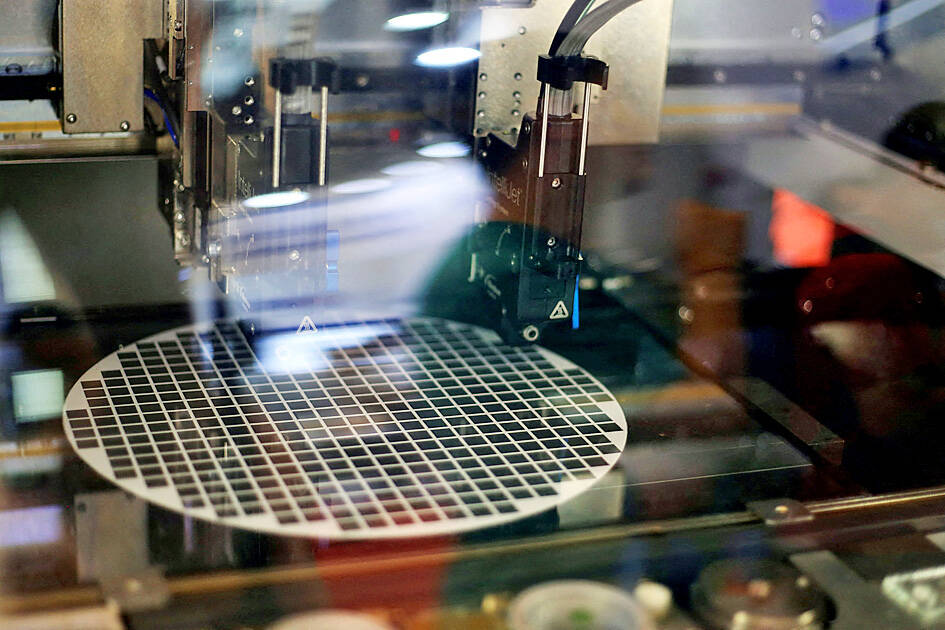Taiwan is expected to be the world’s largest semiconductor fab equipment spender next year at US$23 billion, due to heavy spending by local foundry companies led by Taiwan Semiconductor Manufacturing Co (TSMC, 台積電), international trade group SEMI said yesterday.
Taiwanese chipmakers would spend 4 percent more next year on fab equipment than this year, SEMI said.
Ranking second, South Korea would increase its fab equipment spending by 41 percent to US$22 billion next year to reflect a recovery in demand for memory chips, while spending in China would slide to US$20 billion due to US export controls, SEMI said.

Photo: Reuters
“Despite the constraints, Chinese foundry suppliers and IDMs [integrated device manufacturers] are expected to continue investments in mature process nodes,” it said.
Washington imposed bans on the supply of 14-nanometer and 7-nanometer chipmaking equipment to China last year, aiming to slow China’s advances in technology.
The US is expected to hold steady at fourth spot, with spending jumping 23 percent to a record US$14 billion next year, while Europe and the Middle East would also post record investments, with spending soaring 41.5 percent to US$8 billion next year, SEMI said.
Fab equipment spending in Japan and Southeast Asia would likely increase to US$7 billion and US$3 billion respectively next year, it said.
Global chipmakers would see fab equipment spending rebound by 15 percent next year to US$97 billion to cope with recovering demand for chips used in high-performance computing devices and memory chips following inventory adjustments, it said.
In March, SEMI estimated that fab equipment spending would rise to US$92 billion next year.
By segment, foundry companies would lead semiconductor expansion this year with total investments of US$49 billion, up 1 percent from last year, it said.
Next year, their spending would increase 5 percent to US$51.5 billion, as chipmakers expand capacity in leading-edge and mature process nodes, SEMI said.
Memorychip makers led by Samsung Electronics Co would spend US$27 billion on equipment next year, a 65 percent increase, thanks to a 40 percent raise in spending by DRAM makers and a 113 percent jump in spending by NAND producers, it said.
SEMI president and CEO Ajit Manocha said the decline in equipment investment this year is less serious than expected, while the recovery next year would be better than forecast earlier.
“The trend suggests the semiconductor industry is turning the corner on the downturn and [is] on a path back to robust growth fueled by healthy chip demand,” Manocha said in a statement.
Last year, inventory corrections took a toll on equipment spending with global spending sinking 15 percent annually to US$84 billion, SEMI said.

MULTIFACETED: A task force has analyzed possible scenarios and created responses to assist domestic industries in dealing with US tariffs, the economics minister said The Executive Yuan is tomorrow to announce countermeasures to US President Donald Trump’s planned reciprocal tariffs, although the details of the plan would not be made public until Monday next week, Minister of Economic Affairs J.W. Kuo (郭智輝) said yesterday. The Cabinet established an economic and trade task force in November last year to deal with US trade and tariff related issues, Kuo told reporters outside the legislature in Taipei. The task force has been analyzing and evaluating all kinds of scenarios to identify suitable responses and determine how best to assist domestic industries in managing the effects of Trump’s tariffs, he

TIGHT-LIPPED: UMC said it had no merger plans at the moment, after Nikkei Asia reported that the firm and GlobalFoundries were considering restarting merger talks United Microelectronics Corp (UMC, 聯電), the world’s No. 4 contract chipmaker, yesterday launched a new US$5 billion 12-inch chip factory in Singapore as part of its latest effort to diversify its manufacturing footprint amid growing geopolitical risks. The new factory, adjacent to UMC’s existing Singapore fab in the Pasir Res Wafer Fab Park, is scheduled to enter volume production next year, utilizing mature 22-nanometer and 28-nanometer process technologies, UMC said in a statement. The company plans to invest US$5 billion during the first phase of the new fab, which would have an installed capacity of 30,000 12-inch wafers per month, it said. The

‘SWASTICAR’: Tesla CEO Elon Musk’s close association with Donald Trump has prompted opponents to brand him a ‘Nazi’ and resulted in a dramatic drop in sales Demonstrators descended on Tesla Inc dealerships across the US, and in Europe and Canada on Saturday to protest company chief Elon Musk, who has amassed extraordinary power as a top adviser to US President Donald Trump. Waving signs with messages such as “Musk is stealing our money” and “Reclaim our country,” the protests largely took place peacefully following fiery episodes of vandalism on Tesla vehicles, dealerships and other facilities in recent weeks that US officials have denounced as terrorism. Hundreds rallied on Saturday outside the Tesla dealership in Manhattan. Some blasted Musk, the world’s richest man, while others demanded the shuttering of his

Taiwan’s official purchasing managers’ index (PMI) last month rose 0.2 percentage points to 54.2, in a second consecutive month of expansion, thanks to front-loading demand intended to avoid potential US tariff hikes, the Chung-Hua Institution for Economic Research (CIER, 中華經濟研究院) said yesterday. While short-term demand appeared robust, uncertainties rose due to US President Donald Trump’s unpredictable trade policy, CIER president Lien Hsien-ming (連賢明) told a news conference in Taipei. Taiwan’s economy this year would be characterized by high-level fluctuations and the volatility would be wilder than most expect, Lien said Demand for electronics, particularly semiconductors, continues to benefit from US technology giants’ effort